We work on many projects, and the following is a snapshot, as of January 2021.
Barium Tagging for Neutrinoless Double Beta Decay

One of the fundamental open questions in physics is the nature of the neutrino. This question Is believed to be intimately connected to the mysterious abundance of matter over antimatter in the Universe, and to beyond-standard-model physics at extremely high energy scales. Currently the most sensitive approach to determine if the neutrinos are Majorana fermions is the search for Neutrino-less double beta decay. This hypothetical process, if it occurs at all, has a very long half life and if detected would be the slowest process ever observed (>10^26 years). Such an observation is extremely difficult, and involves overcoming pernicious radioactive backgrounds that are intrinsic to all detector materials.
One way to reject all backgrounds to double beta decay to a negligible level is to identify the daughter barium nucleus emerging from the double beta decay of xenon – an approach generically called “barium tagging”. Although widely understood to be an extremely powerful future technique, a credible method of in-situ single ion barium tagging has yet to been demonstrated. The UTA Neutrino and Rare Event Searches group has pioneered new technological approaches to barium tagging that couple single molecule fluorescent imaging techniques from biochemistry with high pressure gas time projection chamber detectors. We have partnered with the Foss organic chemistry group to develop a set of custom fluorescent molecules for sensing barium ions. This has been accompanied by development of a new type of microscopy where the microscope resides in a Nobel element environment, and RF-based ion concentrators for in-detector sensing of barium. We were the first group in the world to image a single barium diction (image inset), and have now demonstrated a new class of dyes with dry function, working in high pressure environments. We are presently developing a demonstrator detector called NEXT-CRAB that will prove barium tagging in a true double beta decay detection environment with two neutrino double beta decays.
Atomic Tritium Beamline Cooling for Project 8
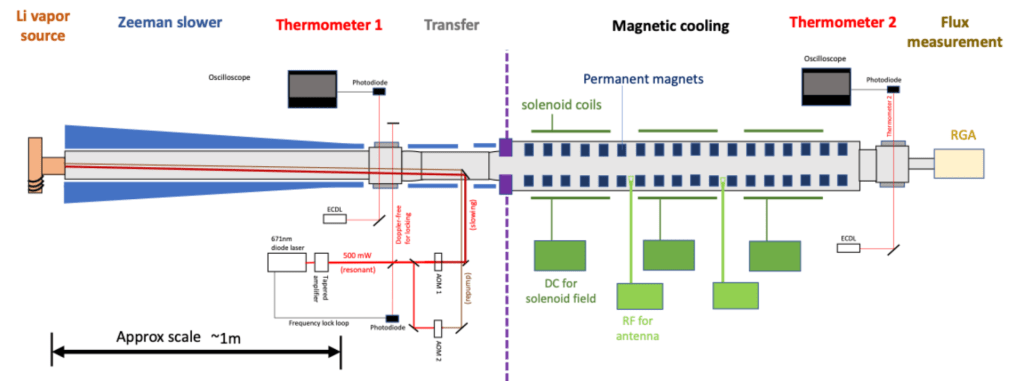
Project 8 aims to measure the mass of the neutrino through precise energy reconstruction of the recoiling electrons from tritium beta decay. Tritium naturally forms the molecule T2, and when one of the T atoms in T2 beta decays, the result is a measurable electron, an unobserved neutrino, and a molecule of HeT. The sensitivity of searches for neutrino mass in the laboratory are now so precise that the tiny amount of energy left in the vibrating final molecule is enough to compromise the measurement. UTA is working with collaborators at the University of Washington, JGU Mainz and the University of Illinois to overcome this limitation by developing a source of cold, trapped atomic tritium. A crucial part of this system is a beam line that can cool tritium from 2200 K where it is cracked into atoms, to 1 mK where it can be trapped in a magnetic bottle, a technological feat that has never been accomplished. UTA is responsible for making the first proof of this magnetic cooling process and studying its performance using beams of partially cooled atomic lithium.
Searches for Sterile Neutrino Oscillations at IceCube
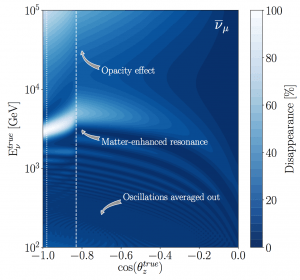
The IceCube Neutrino Telescope is a billion-ton, ice Cherenkov detector at the South Pole. In addition to being a telescope for studying ultra-high energy astrophysical neutrinos, IceCube can also measure the properties of neutrinos produced in the atmosphere of the Earth. The UTA group works in collaboration with our colleagues at MIT and Harvard to search for signatures of exotic particles called sterile neutrinos. The one-year IceCube search for eV-scale sterile neutrinos was the most sensitive in the world. We recently co-led an advanced analysis yielding new results from this search using IceCube’s 8-year dataset containing more than 300,000 neutrino events, further increasing its world-leading sensitivity in the region of interest to short-baseline neutrino anomalies. Our group continues to refine understanding of the IceCube detector, and extend its power to seeking evidence of other types of new physics phenomena in high energy neutrino oscillations. We also co-lead the Neutrino Oscillations Working Group at IceCube, which is in the process of preparing the worlds most sensitive test of standard atmospheric neutrino oscillations.
The NEXT-CRAB (Camera Readout and Barium Tagging) Program
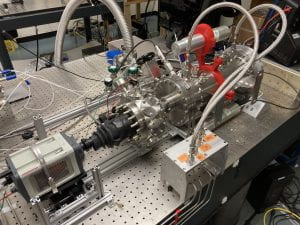
The UTA Neutrinos and Rare Events Searches group co-leads the NEXT-CRAB (Camera Readout and Barium Tagging) program with our collaborators at Argonne National Laboratory (ANL). The goals of the NEXT-CRAB program are to demonstrate a time projection chamber with flexible readout that is easily scalable to the ton- to multi-ton scale, and that may straightforwardly incorporate continuous, online barium tagging systems. The detection concept employs direct vacuum-ultra violet imaging with image intensified high speed cameras. The first prototype-scale device with image intensified optical readout, CRAB-0, was brought into operation at the UTA high pressure xenon gas laboratory in April 2021. We are now working to develop a demonstrator at the 10kg scale at ANL.
Searches for Non-standard Neutrino Oscillations at IceCube
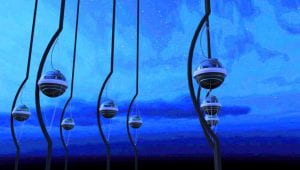
The data collected by IceCube Neutrino Observatory in the South Pole can be used to test for many types of hypothetical non-standard oscillation mechanisms that would illuminate neutrino physics beyond the Standard Model. One compelling beyond-standard-model scenario is the existence of new interactions between neutrinos and matter, a generic prediction of a wide variety of new physics models realized via dimension 6 (or higher) operators. These non-standard interactions (NSI’s) would introduce novel oscillation effects in the atmospheric neutrino fluxes measured at IceCube, with a magnitude that depends on the density of matter traversed and neutrino energy. UTA has recently led the most precise search for any neutrino non-standard interaction from any experiment in any oscillations channel. A paper is presently under review by Physical Review Letters.
Another beyond-standard-model oscillation effect that is uniquely testable at IceCube is anomalous decoherence, a plausible signature of quantum gravity. Decoherence is the process of a quantum state converting into a classical superposition, potentially through interaction with an external environment, through dynamics of spacetime foam, or through light-cone fluctuations. In many decoherence models the effect increases with the energy of the neutrino beam, and thus IceCube’s ultra-high energy 1-100 TeV neutrinos are uniquely sensitive to this possible new physics. The UTA Neutrinos and Rare Event Searches group is developing new techniques to search for this effect using IceCube’s high energy muon neutrino sample.
Construction and Commissioning of the NEXT-100 Experiment
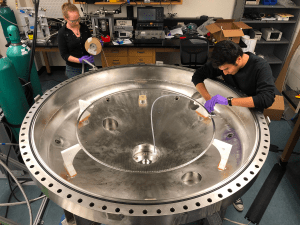
NEXT-100 is the forthcoming iteration of the NEXT program, a sequence of high pressure xenon gas time projection chambers working towards creating a ton-scale, very low background neutrinoless double beta decay search. While most aspects of this technology are easily scalable, some detector elements require R&D in order to be realized on a large scale. NEXT-100 will have the same electronics and sensors as the previous detector, NEXT-White, but all mechanical structures will be scalable to the ton-scale size. This includes high voltage connections reaching 80 kilovolts or more, a scalable field cage, and a large, stable electroluminescence region. UTA designs and tests these components alongside Argonne National Lab before they are assembled and sent for installation at the Laboratorio Subterraneo de Canfranc in Spain.
Analysis of NEXT Data with Deep Neural Networks
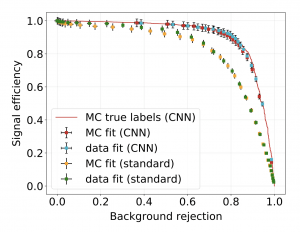
The NEXT-White experiment has produced a rich dataset using both an array of calibration sources and low-background operation at the LSC underground laboratory. The UTA team has worked with our collaborators at ANL and IFIC Valencia to advance the sensitivity of the experiment by employing TPC event reconstruction techniques using both dense and sparse deep neural networks. The effective exposure that can be achieved using DNN-based reconstruction was shown to be a factor of almost two larger than that accessible with classical methods. We have ongoing projects to both improve performance and extend realm of application of DNN based techniques within the NEXT program, including adapting the methods for future ton-scale phases.
Development of Advanced Time Projection Chamber Technology
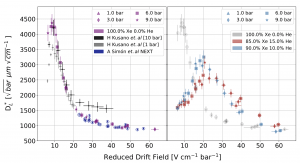
The Time Projection Chamber (TPC), invented by UTA REST group member David Nygren in 1974, is a type of 3D tracking calorimeter that has become pervasive in particle physics. TPCs are used worldwide to test for Majorana neutrinos, search for dark matter, measure neutrino oscillations, study collisions at the LHC, and more. Our group continues to study and hone TPC technology, developing novel gas mixtures with ulta-low diffusion and new methods for cosmogenic background mitigation via neutron capture, extending optical detection capabilities, developing new readout methodologies, and creating micro-physical simulations to study and improve performance of gas-phase TPC detectors. We participate in both the DUNE MPD and NEXT programs, as well as collaborating with the UTA neutrino physics group to create enabling new technologies for liquid argon experiments such as the DUNE far detector.
Explorations in Neutrino Phenomenology
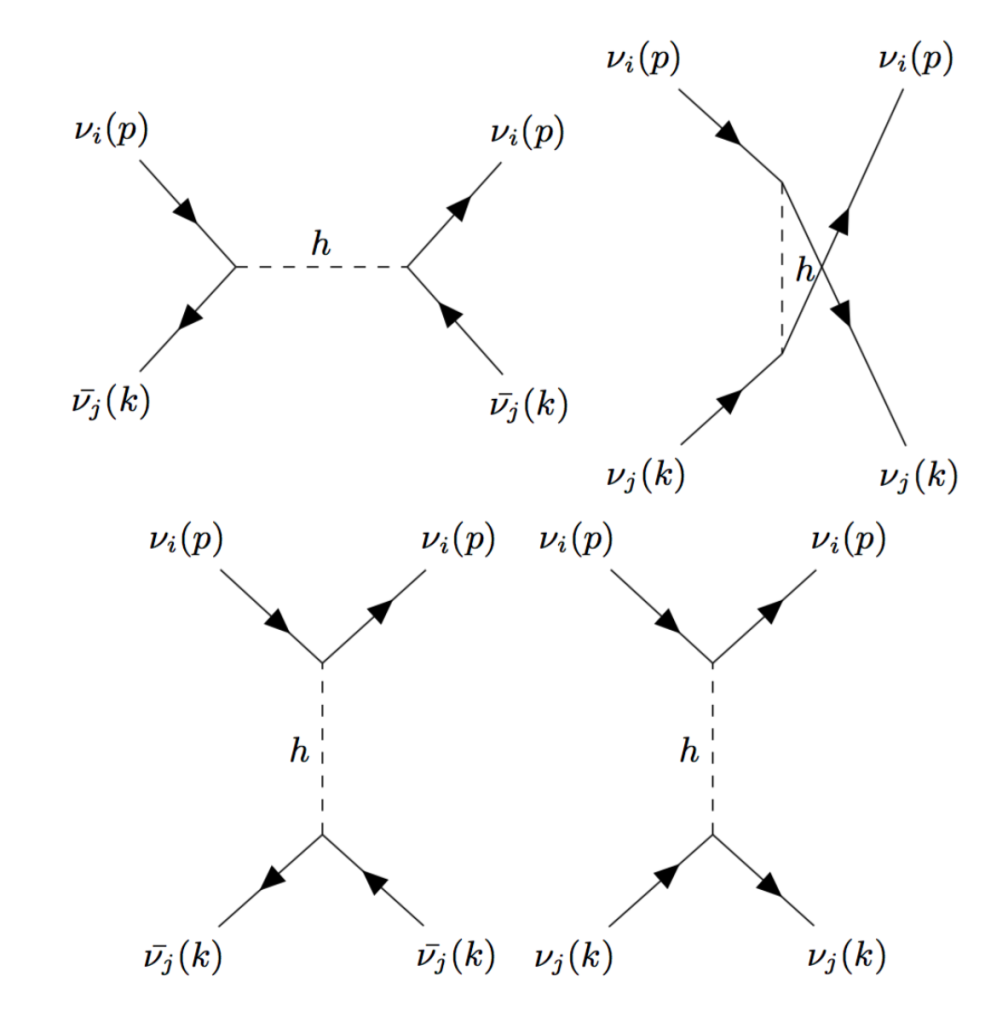
We are committed to developing and exploring new ideas in neutrino physics and beyond – from working to understand what the LSND and MiniBooNE neutrino anomalies can tell us about physics beyond the standard model, to studying the production of high energy neutrinos from cosmic ray interactions in the sparse atmosphere of the Sun. We have also developed methods for simulating neutrino oscillations for quantum processors, and recently extended this work for encoding N-dimensional neutrino mixing matrices on quantum computers.
Creativity and the desire to explore are key elements of the scientific process, and all members of our group are encouraged to follow their ideas where they lead. We believe that every anomaly is an opportunity, and every idea is an invitation.